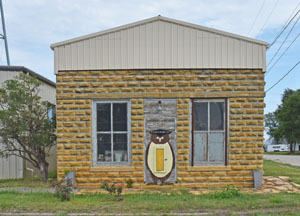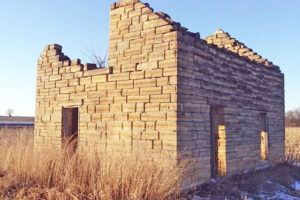
Old business building in Omio, Kansas.
Omio, Kansas, in Vicksburg and Grant Townships, was located in the eastern part of Jewell County, 15 miles from any other town. Today, the town is gone, and only one building remains to prove it ever existed.
The area began to be settled after a great influx of pioneers rolled into north-central Kansas in 1870.
In the 1870s, someone discovered a vein of coal a couple of miles west of Omio, a prize that residents hoped would also attract interest in a railroad. A shaft was dug down to 70 feet when it was discovered that the coal was not the type railroads wanted to burn.
The town was laid out in May 1877 in the middle of the fertile Marsh Valley by J.O. and A.J. Godding, J. Fogle, and C. Green, all trustees of the “Huron Town Company.” That year, G.A. Boal opened the first store in July 1877, and a post office called Omio was established on July 5. Martha and C. W. Green organized the Omio Baptist Church that year.
O.J. Quy, an immigrant from England, an early settler, and one of the community’s early businessmen built the Quy Hardware Store at Main and Kansas Streets in Omio. R.G. Patterson, a merchant and stock dealer originally from Ireland, engaged in general merchandising in Omio in 1878 and built his store building the same year. The owner of 960 acres of land also dealt in stock and kept 400 heads of cattle, 325 heads of sheep, and 25 heads of horses.
In December 1878, E. Crew instituted a branch society of the Independent Order of Good Templars, which soon had about 40 members.
On February 11, 1879, B.F. Dow, originally from Maine, began merchandising in Omio. That year, School District 141 was organized.
In 1880, B.F. Dow built a 20×40-foot stone store and carried a stock of general merchandise. That year, the Methodist congregation was organized.
At that time, Omio had a livery, a druggist, two blacksmith shops, three general stores, a harnessmaker, three physicians, a surgeon, a veterinarian, a milliner, a grocery store, a loan agent, a hotel, a grocery store, a butcher, a wagon maker, a boot and shoemaker, a carpenter and builder, a dealer in farm implements, and the Omio Journal newspaper. It also had a Methodist Episcopal church and a district school. The daily stagecoach between Mankato and Scandia delivered mail to George A. Boal, postmaster. The town shipped wheat, hogs, and dairy products from Scandia, its nearest shipping point. It had a population of 90.
The town had hope for the Hardy, White Rock, Omio, and Beloit Railroad Company, but it failed to live up to those hopes and expectations.
In August 1881, Charles S. Vaughn, in conjunction with his brother S.F. Vaughn, established the Western Advocate newspaper at Omio. At that time, the township had four school districts, and the Omio schools were in good condition.
In the late 1880s, the Chicago and Rock Island Railroad bypassed Omio and went three miles north, and the settlement of Formoso began to develop.

O.J. Quy’s hardware store once stood in Omio before it was moved to Formosa. Today, the building is utilized by the Water Department. Photo by Kathy Alexander.
The Formoso Town Company offered discounted lots to businesses and homeowners moving from Omio. Several merchants decided to move their businesses to Formososo. Rock buildings from Omio were taken apart and moved brick by brick, while others were put on skids and hauled by teams of horses.
This included O.J. Quy’s hardware store, whose limestone building was separated block by block. After the blocks were numbered, they were hauled to Formoso, and the building was reconstructed at Main and Patterson Streets. He received a 75% discount on the purchase of his lot, paying only $50 for it. A street was named after him as he was involved with those platting the town. Quy Street runs east and west across the south side of Formoso. The building still stands in Formosa today and is used by the city’s water department as a maintenance department.
Omio’s post office closed on August 31, 1889. A post office was authorized from 1890 to 1895 but never operated.
The Omio school district was disorganized on January 4, 1910.
Today, all that is left of Omio is its old limestone brick post office, located about 2.25 miles south of Formosa.
The community was located at the Omio Road (280 Road) and M Road intersection, about three miles south of Formoso. It was 16 miles east of Mankato and 14 from Scandia.
©Kathy Alexander/Legends of Kansas, November 2024.
Also See:
Extinct Towns of Jewell County
Sources:
Cutler, William; History of the State of Kansas, A.T. Andreas, Chicago, IL, 1883.
Lovewell History
Superior Express

